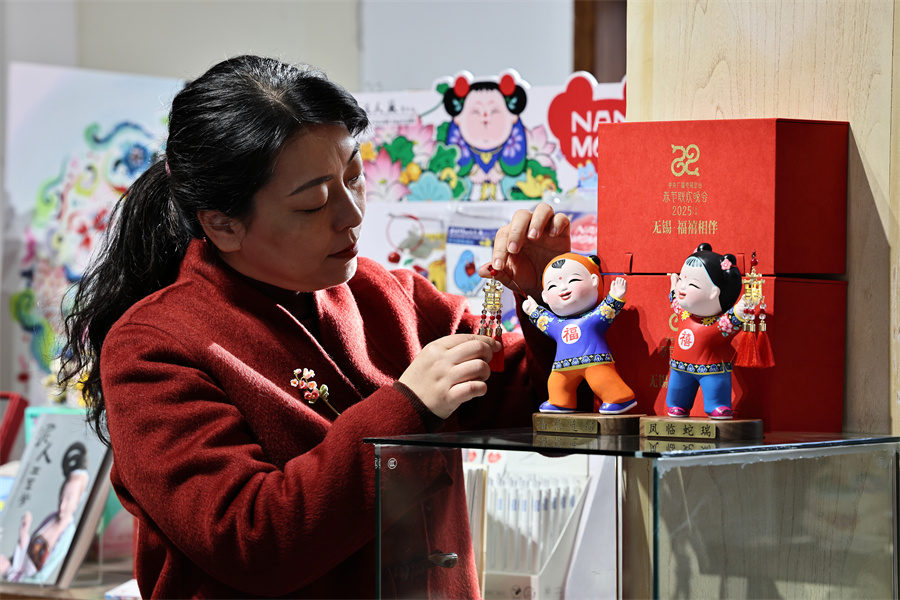
Zhou Lu, an inheritor of Huishan clay figurines, decorates a festive edition of miniature clay sculptures for the Year of the Snake in Wuxi, Jiangsu province.[QIN YAN/FOR CHINA DAILY]
Craftswoman Yu Jihong bent her head down in concentration with a fine-tipped brush in one hand, painting rosy flower petals on a clay figurine designed for this year's Spring Festival.
Though orders had been streaming in ahead of the holiday that began on Jan 29, Yu, chief painting technician at the Wuxi Huishan clay figurine company in Jiangsu province, appeared to be in no rush, dabbing the brush tip in pigments every few strokes to create different shades of pink.
"I want to add more depth and dimension to the decorative flower shapes by layering distinct shades of color, all while showcasing the uniqueness of our craftsmanship," she said.
Huishan clay figurines are a traditional folk art made from black mud collected at the foot of the Huishan mountain in Wuxi city. With a recorded history of over 400 years, the craft was added to the national intangible cultural heritage catalog in 2006.
Among an array of characters from Chinese folklore and operas that are depicted through these clay figurines, the best-known variation features a pair of plump, jovial figures symbolizing good fortune and joy.
Because Wuxi was selected as one of the four sub-venues of the widely watched CCTV Spring Festival Gala, local artisans devised a special version based on this pair and promoted them as mascots for the event staged in the city.
Zhou Lu, a municipal-level inheritor of the Huishan clay figurine like Yu, said that while the traditional version is typically seated and exudes a static, reserved demeanor, the newly designed rendition conveys a stronger sense of liveliness.
"The head and body are crafted separately, and its posture is more animated with the hands and arms stretched out wide," she said.
Zhou added that the male figure of the pair dons a persimmon-shaped cap and the female flaunts double hair buns — both styles symbolizing blessings for the new year.
Zhou specializes in shaping the clay form of a figurine before passing the object to Yu, who applies paints to give texture to the surface. The product will then be dried in cool, shaded areas for several days before being packaged and shipped out.
"The entire process is handmade, and I am capable of crafting a maximum of 11 figures each month on my own," she said.
The public's enthusiasm for the new products has exceeded her expectations.
"The new figurines associated with the Spring Festival gala are so popular that the wait time for pre-sale orders has extended from 30 days initially to 90 days at present," she said during an interview in late January.
"Our orders are full through April," she added.
Zhou chalked up the surging popularity to extensive media exposure linked to the Spring Festival gala.
A self-proclaimed traditionalist, Zhou said she rarely paid attention to media reports or promotions in the past, but the recent surge of attention has surprised her and prompted a rethink on social media.
"I recently downloaded the short-video platform Douyin and am learning to navigate the app," she said. "I plan to use social media and short clips to promote the folk art so that more people will discover it and even fall in love with it."
According to the company, clay figurines were used solely for display purposes. It is now exploring adorning clothing and food packages with characteristic images, and producing related soft toys and decorations.
The company has also partnered with catering businesses, hotels, cosmetic brands and marathon organizers to enhance public awareness and breathe vigor into the historic craft.
"We will certainly uphold tradition, and at the same time, we want to show that we have the potential to become an internet sensation," she said.